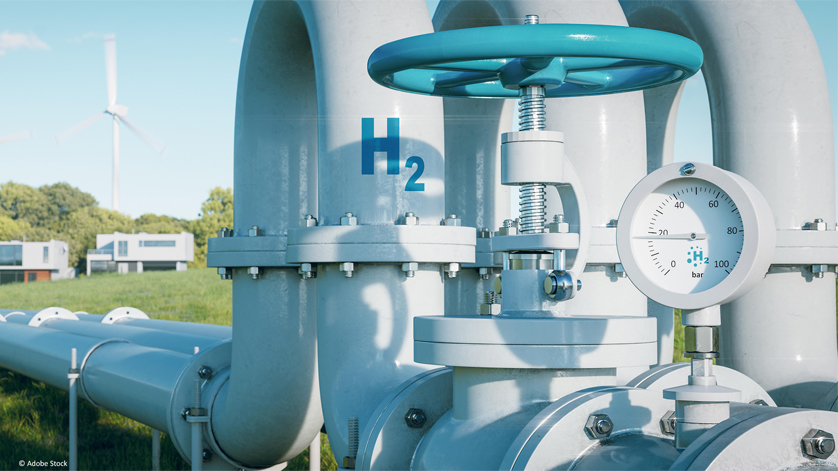
Pressure gauges play an important role in the production, storage, transport and use of hydrogen. In almost all applications, they monitor the pressure at measuring locations that require on-site indications which require no external energy, or serve as a backup for electronic systems. As an alternative energy source in the fight against climate change, H2 has promising future potential, but poses some challenges for measurement technology. What does this mean for the use of pressure gauges?
Hydrogen is the smallest molecule. It therefore quickly penetrates many materials (permeation) or causes embrittlement. For this reason, stainless steel pressure gauges with wetted parts made of 316L are predominantly suitable for hydrogen applications, especially in the high pressure range, for example the WIKA models 23x.30 and 23x.50. This is because selected austenitic steels, such as 316L, are resistant to embrittlement by H2.
In pressure gauges, permeation by hydrogen plays a minor role
Permeation plays only a minor role in pressure gauges, in contrast to electronic pressure measuring instruments or diaphragm seals, where the hydrogen that diffuses in can falsify the measuring result. Such effects can be ruled out with pressure gauges as a result of the measuring principle. Nevertheless, in the event of permeation over a long period of time, hydrogen can escape through the measuring element into the pressure gauge case. Due to the case design (plastic components, among other things), a concentration equalisation then takes place during normal operation. Therefore, it is always recommended to use the pressure gauge in a ventilated environment.
In most applications, H2 occurs in gaseous form and is usually exposed to pressures of between 60 bar (initial bottling) and 1,000 bar (filling stations). The EN 837-2 user standard for the selection and installation of pressure gauges recommends pressure gauges in safety version, at least level S2, for gases and pressures > 25 bar. With stainless steel pressure gauges, however, the safety versions S1 (e.g. WIKA model 23x.50) and S3 (e.g. WIKA model 23x.30) are the market standard.
Tabular overview of selection criteria and safety aspects for pressure gauges in accordance with EN 837-2
| Measuring material | Case filling | Nominal size | Display range | Recommended minimum case design according to the standard |
Recommended WIKA pressure gauges | |
| Gas | Without | < 100 mm | ≤ 25 bar | 0 | 23x.50, 23x.30 | |
| > 25 bar | S2 | 23x.30 | ||||
| ≥ 100 mm | ≤ 25 bar | S1 | 23x.50, 23x.30 | |||
| > 25 bar | S3 | 23x.30 | ||||
| With | < 100 mm | ≤ 25 bar | S1 | 23x.50, 23x.30 | ||
| > 25 bar | S2 | 23x.30 | ||||
| ≥ 100 mm | ≤ 25 bar | S1 | 23x.50, 23x.30 | |||
| > 25 bar | S3 | 23x.30 |
Device versions:
0 = Pressure gauge without relief opening
S1 = Pressure gauge with relief opening
S2 = Pressure gauge without shatter-proof partition
S3 = Pressure gauge with shatter-proof partition
Instruments with the highest safety levels
WIKA therefore recommends the model 23x.30 (232.30 or 233.30) with the highest safety level, S3, as the first choice for hydrogen applications. The instrument consists of a shatterproof window, a solid baffle wall between the measuring system and the dial, and a blow-out back. Therefore, in the event of a fault, components or medium only escape via the rear of the case. The operating personnel at the front are therefore protected.
Also in an “oil and grease-free” variant and as an ATEX version
In addition to the “oil and grease-free” version, WIKA also supplies the pressure gauge as an optional ATEX version. They are therefore also suitable for those measuring locations where there is a risk of explosion due to the high flammability of certain hydrogen mixtures.
Note
On the WIKA website you can discover all the technical details about the pressure gauge models 232.30, 233.30 and 232.50, 233.50, and download the manufacturer’s declaration on hydrogen suitability. We also present other H2 measuring solutions on the website. Would you like to buy the model 23x.30 or model 23x.50 pressure gauge? In our WIKA online shop you’ll find some of our standard versions. If you have any questions, your contact will gladly help you.
Also read our posts
Repeal of EC79/2009 for hydrogen-powered vehicles: Impact on pressure sensors
Pressure switch in hydrogen-powered train ensures safety
WIKA develops pressure sensor for hydrogen-powered vehicles
Hydrogen mobility: Clean engines of the future offer the convenience expected
Turning hydrogen into kilometres
Hydrogen and pressure sensors: What must be observed?

